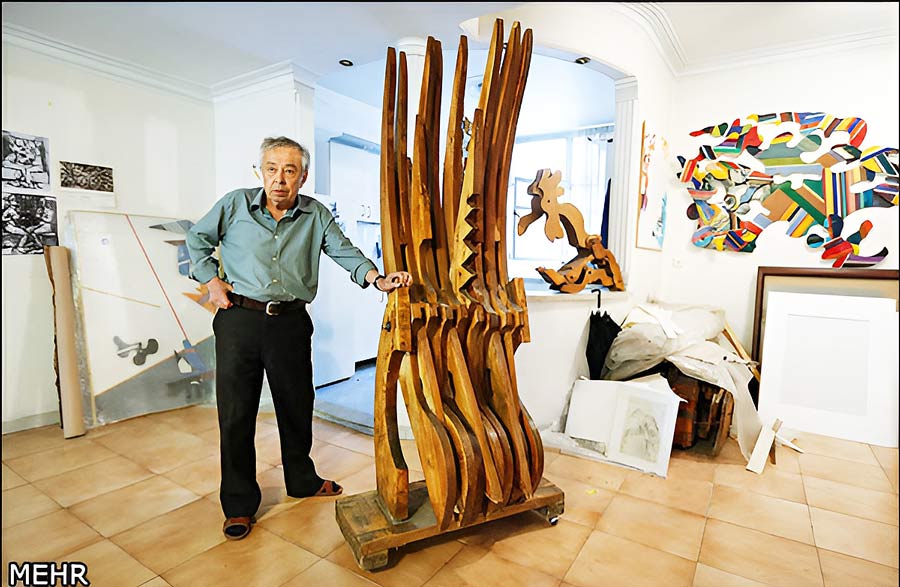A week with late painter Mohsen Vaziri Moghaddam

In the past week, an event entitled “Mohsen Vaziri Moghaddam > centenary” with the exhibition of the works of this late artist on his centenary, started in 10 galleries of the Iranian capital, which will continue until October.
A report of Amaga.ir quoted by Mehr News Agency, the Mohsen Vaziri Moghaddam Foundation, under the management of Hamon, the living son of Moghaddam Vaziri, organized the event “Mohsen Vaziri Moghaddam > Centenary” on the centenary of the artist who died in Rome in 2018 at the age of 94. It will be held this month until October. In this event, several cultural activities have been dedicated to Mohsen Vaziri Moghaddam.
This event, which was implemented under the supervision of Hamon Vaziri Moghaddam, began in June and will continue until October 2024. The manager of this project is Zohreh Deldadeh. Mohsen Vaziri Moghaddam Foundation has dedicated many cultural activities to this artist. This event will be held in collaboration with the galleries of 009821 projects, Etemad Yak, Sam Center, Zirzmin Dastan, Bavan, Madar Movazi, Azad Designers Gallery, ValI, Bostan and 2+ [Fereshteh], which started on the last Friday of June, at the same time.
Exhibition of Vaziri Moghaddam’s modernist paintings at Edemad Gallery
In the statement of the special exhibition of the life of Mohsen Vaziri Moghaddam, in Etamad Gallery, it is stated: “When Vaziri Moghaddam moved to Italy (he lived there from 1954 to 1962), the formalist concepts of modernism had become a rigidly established paradigm. During his studies at the Academy of Fine Arts, the Italian masters were very skilled at understanding and communicating these ideas effectively. Attending these courses opened Vaziri Moghaddam’s mind to the modern articulation of visual elements, quickly leading him to pure modernist painting and cementing his lifelong commitment to abstraction.
The late Vaziri Moghaddam spent some time in Toti Shaloya’s studio, “Black and White”, and the concept of minimalist art came to his mind there for the first time; A wide range of avant-garde ideas (from cybernetics to Zen philosophy) were discussed here.
Artists such as Pino Pascali, Maria Pioppi, Mario Chiroli, Yanis Konlis, Behjat Sadr and Mohammad Malehi also participated in Shaloya’s training course and in an exceptional framework of experience and in a new intellectual atmosphere, they became long-term companions of Vaziri Moghaddam in life and education. .
Vaziri Moghaddam’s art, close to an esoteric attitude and beyond appearances, does not simply reveal its deep material and temporal process, let alone its effects.
Mohsen Vaziri Moghaddam, during six decades of continuous and methodical artistic activity, displayed one of the most original examples of modernist art in Iran, which is best expressed in his abstractionism.

Vaziri Moghaddam’s abstract paintings at Azad Designers Gallery
In statement of special exhibition of life of Mohsen Vaziri Moghaddam, at Azad Designers Gallery, it is stated: “From perspective of Vaziri Moghaddam, abstract painting created an unprecedented revolution in painting of 20th century. Open inner through visual imagination. He does not separate art from human life and believes that artistic activity is directly derived from lived experiences; “I look for depth and human emotions and deep thoughts. Painting is philosophy, knowledge and vision of a human being, at a certain time, which is transferred to viewer. “Now that my eyes are damaged, I’m working on another kind of abstraction that is cosmic in nature and beyond nature and ordinary life.”
In works of this exhibition, which belong to last 2 decades of artist’s life, he tries absolute abstraction. Effects of artist’s gradual loss of vision can be seen in blurring of lines and dominance of white surfaces that appeared in his field of vision and disturbed his vision.
In statement of late Mohsen Vaziri Moghaddam‘s special exhibition at Zirzamin Dastan Gallery, it is also stated: “The current collection of monotypes was created in continuation of successful and popular experience of Vaziri Moghaddam’s sand paintings. Vaziri Moghaddam‘s energetic and inquisitive spirit led him to try expressive and spontaneous action of finger prints in sand paintings through other mediums as well.
In monotypes, Vaziri Moghaddam extend interaction and contact of his fingers with sand directly to painting and uses medium of monotype printing to record and preserve these effects. Potential of this medium for mixing patterns and colors as well as creating diverse textures is shown in richness and vitality of these works.
In statement of special exhibition of life of Mohsen Vaziri Moghaddam in 009821 projects gallery, it is also stated: “Mohsen Vaziri Moghaddam, by entering Faculty of Fine Arts of University of Tehran in 1944, joined a generation of leading artists who were leaders of modernist movement of contemporary art and literature in Iran. were counted The limited scene of visual arts at that time was mainly dominated by classical style of master painter Kamal al-Molk (1848 – 1940) and his students, who carefully imitated classical and representational methods of old European masters and depicted local subjects and elements.
Embracing new artistic experiences with Articulated Sculpture
In statement of special exhibition of life of Mohsen Vaziri Moghaddam at Bavan Gallery, it is stated: “1971 is an epoch-making moment in artistic work of Mohsen Vaziri Moghaddam; An important exhibition of his articulated wooden sculptures will be held this year at Iran-America Association (Tehran), and a new level of artistic innovation will be displayed in his work. In this period, artist’s focus is on making large sculptures, whose elongated and jagged arms are connected to middle parts with joints, allowing for manipulation and movement. These sculptures are created from intersection of flat and colorful plates and allow artist to expand his artistic expression in a three-dimensional space. Although Vaziri Moghaddam previously considered himself more of a painter, this exploration of sculpture reflects his desire to push back boundaries and embrace new artistic experiences.
These sketches show artist’s exploration of modern idea of composition and reveal his continued interest in painting during a period focused on sculpture. Vaziri Moghaddam‘s mastery of basic principles of modern painting, along with his fluid and lively approach, is evident in these activities. Important point is that Vaziri Moghaddam’s abstract approach, unlike many non-western artists, is not based on decorative elements based on native motifs; Instead, his approach is rooted in classic modernist practices, such as cubist analysis of space and interplay of visual elements. Examining circle of artists who have been Vaziri Moghaddam’s friend and companion in these years, especially Piero Doratsio, reveals these connections and mutual influences.
Panic and flight canvases in Madar Movazi
In statement of late Mohsen Vaziri Moghaddam‘s special exhibition at Madar Movazi Gallery, it is stated: “Fear and flight designs, which have been exhibited for first time in Iran, are a valuable opportunity to observe the evolution of Mohsen Vaziri Moghaddam‘s thought and visual transformation of his work in creating one of his most innovative collections. provide
Tension and unrest governing space of these sketches is continuation of Solzhenitsyn’s anxiety, which by mixing color and focusing on composition, enters a realm of conflict and suspension of rough and jagged forms. According to Pierre Rastani: “Sense of threat and widespread violence in world is realized through intense and trembling shapes and colors.” Bird that escapes from rough and fork-like forms, which first appeared in Solzhenitsyn’s etudes, is a recurring theme in these works.
Vaziri Moghaddam, says about it: “Perhaps this dove flying here is my own soul running away from all injustices and sorrows that surround me. Of course, this is an example, but in any case, it shows anger and conflict of innocent people who don’t know what to do.”
Also, series “Fear and Flight Canvases” covers various aspects of Vaziri Moghaddam‘s artistic achievements. In these works, curved and jagged three-dimensional forms move from sculpture to painting and provide possibility of movement, change and manipulation in space. Works oscillate between painting, bas-relief and sculpture, and with their fusion and adaptability, they challenge boundaries and conventional definitions of mediums and also demand a re-evaluation of established artistic concepts and a broader understanding of artistic expression.
Experimentation with aesthetic characteristics of Iranian calligraphy
In statement of special exhibition of Mohsen Vaziri Moghaddam at Vali Gallery, which is dedicated to display of Vaziri Moghaddam‘s calligraphic works, it is stated: “Vaziri Moghaddam’s calligraphic works are a passing experience among different periods of his artistic activity, which shows his searching spirit. It should be noted that Vaziri Moghaddam avoided decorative motifs and native decorative elements almost throughout his career and always adhered to principle of universality of modern art. This approach distinguished him from many modern artists and visual arts traditions of non-Western countries, including Saghakhaneh school, which was popular in Iran at that time and relied heavily on use of decorative and mystical features of native arts.
The present works are among few examples in which late Vaziri Moghaddam has experimented with aesthetic characteristics of Iranian calligraphy and explored its visual capacities. He did this freely and playfully, as he cut tip of pen at right angle, to achieve his desired effects.









